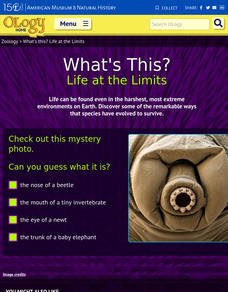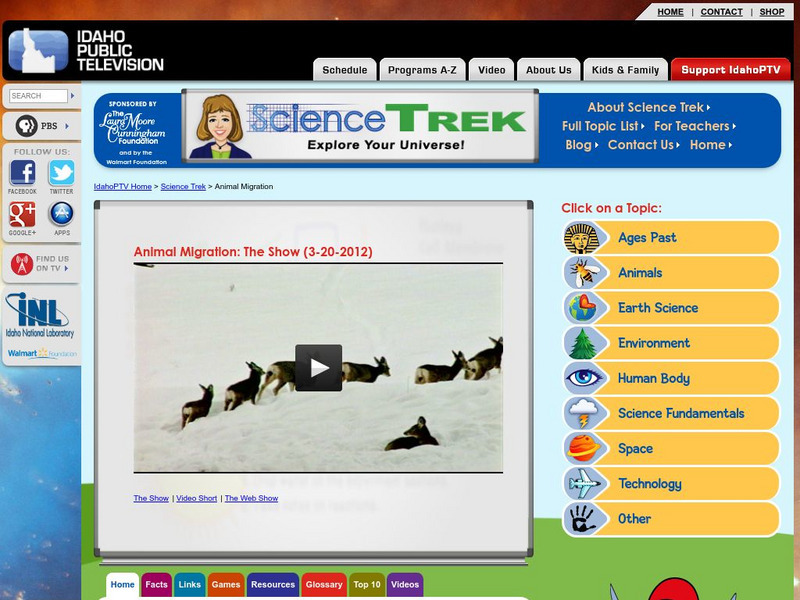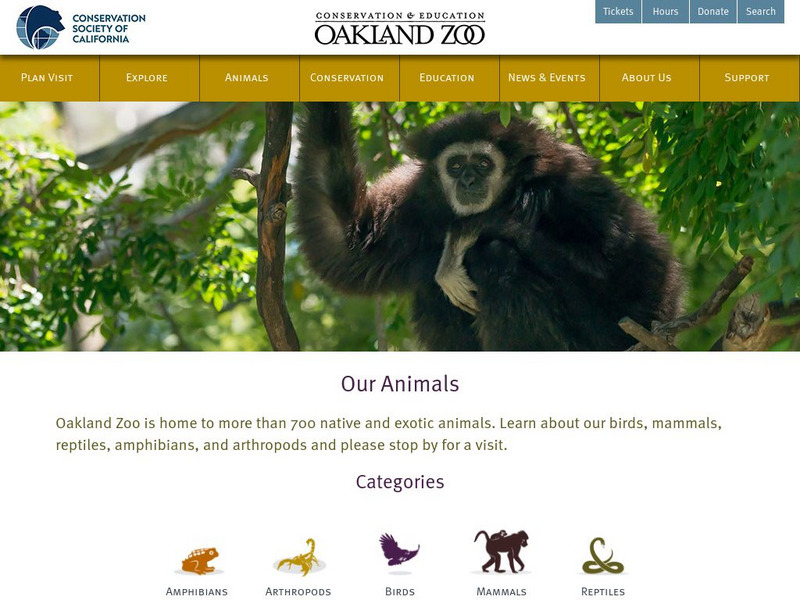American Museum of Natural History
What's This? Life at the Limits
There are some amazing ways species evolve to survive. From large ears to sneezing salt, learners read about these interesting adaptations in an interactive lesson. Great to supplement an in-class lesson, it also works well as a remote...
American Museum of Natural History
What's This? Staying Safe
Amaze the class with the creative adaptations species employ to trick predators. An online interactive lesson introduces learners to six different species with unique adaptations. Each species highlights a different adaptation and its...
American Museum of Natural History
What's This? Reproduction
Attracting the right mate is as important for humans as any other species. An interesting lesson teaches individuals about several strategies that animals and plants have adapted to attract their mates. From colorful nests to powerful...
American Museum of Natural History
Moving Mammals
How many different ways do mammals move from place to place? An online resource uses animation to show how different mammals move. Learners use a slider to speed up or slow down a variety of mammals. The versatile lesson works as a...
American Museum of Natural History
What's This? Colorful Creatures
An online resource shows learners some species that are very good at using their camouflage as well as other ways species use their coloring for survival. Interactive and digital, the lesson is perfect as a remote learning resource.
Scholastic
Scholastic: Dirtmeister's Science Lab: Animal Adaptations
In this lesson plan site, students will investigate what animal adaptations are and how animals are adapted to where they live. A four-step process guides the students in their investigation.
PBS
Pbs Learning Media: Total Solar Eclipse Animation
This brief animation adapted from NOVA illustrates how total solar eclipses form and explains the stages from first contact to totality. [1:14]
PBS
Idaho Ptv: Science Trek: Animal Migration
A comprehensive overview of animal migration. Includes three videos: a half-hour show, a video short, and a short video where an expert answers children's questions. Other features of the site include facts, links, games and activities,...
BBC
Bbc Schools: Ks2 Bitesize: Science: Living Things: Plant and Animal Habitats
Place the aliens in the habitats where they can survive the best. Following the activity, read more about plant and animal habitats, and then take a quick quiz to check for understanding.
Oakland Zoo
Oakland Zoo: Our Animals
This comprehensive resource provides photos and animal fact sheets that list special adaptations for a wide variety of animals. See some animals with their young.
BBC
Bbc: Earth: Tardigrades Return From the Dead
Tardigrades are ancient, fascinating creatures that can survive conditions that would kill most life forms, including extreme heat and absolute zero, extreme pressure and a vacuum, and deadly radiation. They can even survive being...
Woodland Park Zoo
Animal Fact Sheets: Bushmaster
This animal fact sheet explains the pit vipers special adaptions, as well as, reproduction, habitat, and physical characteristics. Information on the venomous Bushmaster including a map and photo.
Online Learning Haven
Online Learning Haven: Animals and Adaptation
This general site defines adaptation and sites examples of some of the best examples of adaptation found in the animal world. Related articles are found at the bottom of this site.
Enchanted Learning
Enchanted Learning: Giraffe Adaptations
Giraffe's have many physical adaptations. This site provides a worksheet and asks students to connect the physical adaptation description to the correct place on the worksheet.
Online Learning Haven
Adaptations: Penguins
An interesting look at the structural and behavioral adaptations of the penguin. Neat penguin facts are included at the end of the site.
PBS
Nh Pbs: Nature Works: Communication
This comprehensive site describes how communication is an adaptation that is important for survival.
PBS
Nh Pbs: Nature Works: Coloration
This competent site describes how structural adaptations help organisms survive. Deceptive and advertising coloration are explained.
PBS
Pbs Learning Media: Seeing Through Camouflage
This interactive feature from the NOVA: "Leopards" Web site presents a wide variety of ways in which animals use coloration to their advantage.
PBS
Pbs Learning Media: Bird Beak Gallery
This collection of images of ten different birds illustrates the diversity of bird beaks.
American Museum of Natural History
American Museum of Natural History: Dinosaurs: Display or Defense?
Are plates of armor, horns, exceptionally large heads, and bony plates examples of dinosaur display or defense? Visitors to this resource will learn what scientists have concluded about the purpose of these peculiar dinosaur features.
PBS
Pbs Learning Media: Atmospheric Oxygen
In this feature, adapted from Interactive NOVA: Earth, students explore the relationship between oxygen concentration and the well-being of various organisms by simulating a change in oxygen levels and observing what happens.
PBS
Pbs Learning Media: Wild Kratts: All About Lizards Lesson Plan
Students explore the diversity of lizards in terms of characteristics, behavior, and habitat. Activities feature five species of lizards and their special body structures needed for survival.
PBS
Pbs Learning Media: Mitosis
This video segment, adapted from the Interactive Secret of Life videodisc, explains the stages of mitosis, the process of dividing equally a cell's massive jumble of DNA just prior to cell division. [1:34]
PBS
Pbs Learning Media: Bird in Flight
Students are asked to explain the characteristics of the bird in flight and how adaptations would allow the bird to fly a particular way. [0:32]
Other popular searches
- Ocean Animal Adaptations
- Fantasy Animal Adaptations
- Plant and Animal Adaptations
- Animal Adaptations Behaviors
- Animal Adaptations +Wetlands
- Animal Adaptations Wetlands
- Animal Adaptations Eating
- Desert Animal Adaptations
- Animal Adaptations to Cold
- Animal Adaptations and Math
- Oceanic Animal Adaptations
- Animal Adaptations Oceans















